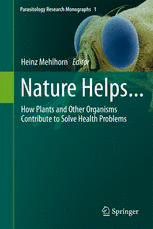Table Of ContentParasitology Research Monographs
Volume 1
Series Editor:
Heinz Mehlhorn
Department of Zoomorphology
Cell Biology and Parasitology
Heinrich Heine University
Universita¨tsstrasse 1
40225 Du¨sseldorf
Germany
For furthervolumes:
http://www.springer.com/series/8816
.
Heinz Mehlhorn
Editor
Nature Helps...
How Plants and Other Organisms
Contribute to Solve Health Problems
Editor
Prof.Dr.HeinzMehlhorn
DepartmentofZoomorphology
CellBiologyandParasitology
HeinrichHeineUniversity
Universita¨tsstrasse1
40225Du¨sseldorf
Germany
[email protected]
ISSN2192-3671 e-ISSN2192-368X
ISBN978-3-642-19381-1 e-ISBN978-3-642-19382-8
DOI10.1007/978-3-642-19382-8
SpringerHeidelbergDordrechtLondonNewYork
LibraryofCongressControlNumber:2011930797
#Springer-VerlagBerlinHeidelberg2011
Thisworkissubjecttocopyright.Allrightsarereserved,whetherthewholeorpartofthematerialis
concerned,specificallytherightsoftranslation,reprinting,reuseofillustrations,recitation,broadcasting,
reproductiononmicrofilmorinanyotherway,andstorageindatabanks.Duplicationofthispublication
orpartsthereofispermittedonlyundertheprovisionsoftheGermanCopyrightLawofSeptember9,
1965,initscurrentversion,andpermissionforusemustalwaysbeobtainedfromSpringer.Violations
areliabletoprosecutionundertheGermanCopyrightLaw.
Theuseofgeneraldescriptivenames,registerednames,trademarks,etc.inthispublicationdoesnotimply,
evenintheabsenceofaspecificstatement,thatsuchnamesareexemptfromtherelevantprotectivelaws
andregulationsandthereforefreeforgeneraluse.
Coverdesign:deblik,berlin
Printedonacid-freepaper
SpringerispartofSpringerScience+BusinessMedia(www.springer.com)
Preface or why such a book
Nature helps ... – of course – at first itself. All living organisms (bacteria, fungi,
plants,andanimalsincludingprehistorichumans)hadandstillhavetosurvivethe
struggle for life, since for millions of years they have been in competition with
manyindividualsoftheirownspeciesandwithevenhighernumbersofcompetitors
belongingtotherestofthelivingsystem,iftheyfitprincipallyintotheconditions
givenataparticularplaceonEarth.
This constant need to be always somewhat better / fitter than competitors was
andisthemotorofevolutionthatledandleadstounbelievablevariationsinbody
shape, astonishing physiological adaptations, and many other admirable abilities.
Thus,thousandsofskilfulmethodsofdefenseagainstattacksfromthesurroundings
havebeendeveloped.Forexample,toxicsubstancesandrepellentsevolvedthatare
used to keep predators away from engorging such individuals. Other species
developedmedicalremedies,whichsupportthewound-healingprocessorincrease
thesuccessofreproductionrespectivelyallowsafastergrowthrateunderfavorable
conditions.Othercompounds(e.g.,prohibitorsoffreezingor“overheating”)helped
survivalinpoorconditionssuchasicywintersorextremeheat.Thesefacilitieshave
been developed over millions of years and all species that had not been able to
develop such facilities, are today no longer visible as they have returned to the
general pool of molecules and elements on Earth. Thus nature is cruel to all
members that are not flexible in the sense described above, and nature eliminates
themforthesakeofthesurvivors.
Of course nature takes its steps slowly by testing the chances and benefits of
more or less occasional mutations of single individuals in a given biotope under
changingenvironmentalconditions.
Itisnotmuchlongerthan100,000yearsagothathumanswerethrownas“last-
minuteman”(ontheverylateeveningofthesixthdayofcreation)intothebattlefor
survivalonEarth.ThissendingtoEarthwasnotonlydonebyGodsaying“Goto
Earth,ruleitandproducesuccessors,”buthumanswerealsoequippedwithasmall
dose of the divine spirit of recognition – of course some received greater insight,
while others received less of this spirit. In any case, the “gifted dwarfs”, i.e.,
humans,developedthe skillsof observationand mental preservation ofimportant
and/or useful events or they recognized helpful facilities of plants and animals in
theirsurroundingsfromtheirearlybeginnings.
v
vi Prefaceorwhysuchabook
Through combination of these empirical observations and by analysis of their
background some of these human “skilful dwarfs” used the abilities of plants and
animals (later also those of fungi and bacteria) to develop products and measures
for survival of diseases or of other critical conditions, which would have killed
nonadaptedcompetitors.
Of course plants were first recognized by mankind as beneficial in times of
disease. Wise women or magicians – often accused of practicing diabolical
witchcraft – have learned over thousands of years to prepare extracts or to use
wholeplantsortheirfruitsasmedicamentsorasimportantcontributionstodaily
food.
Attheverybeginning–apartfromtheisolationofextracts–nobodyreallyknew
theactivecompoundsinplants,forexamplenobodyknew,whythepowderofthe
South American Cinchona tree helped as a powerful remedy against the malaria
fever or why extracts of the bark of the willow (Salix spp.) suppressed fever and
decreasedheadache. As soonasthe methods ofchemistry allowed theanalysisof
details and synthesis processes had been evaluated, medicaments or insecticides
etc.,basedonpurechemicalsweredeveloped(e.g.,quinineandacetylsalicylacid
instead of bark powders of Cinchona or Salix). This industrial production of
chemotherapeutical remedies still flourishing after 100 years, however, led to the
loss of the details of the mostly orally transmitted knowledge on the abilities of
many plants and animals, but also led to the discovery of the effects of useful
bacteriaandfungiashighlyeffectiveantibiotics.
Since these chemicals were very pure and often based on a single active
ingredient,infectiousbacteria,fungi,orparasitesdevelopedincreasingresistances
againsttheseagents,asoccurredinthecaseofMRSA(multiresistantStaphylococ-
cusaureusstrains)wheretheefficacyofchemicalmedicamentsbecameverylowor
even lost. These events make it understandable, why Jean Jacques Rousseau’s
original cry “Back to nature – retour a` la nature” resonates even more loudly
today. This stimulates many scientists to test the efficacies of plants and animals
againstadverseimpactsthatmayaffectplantsandanimalsandrespectivelyendan-
gerhumans.
Thewaveofrelevantplant-basedpapersinmanyscientificjournalsisgrowing
daily, so that single results can hardly be seen. This is due to the fact that many
authors prefertocollectpublishedpapersasgoodiesfor their career andforgetto
developfromtheirresultsusefulremediesforsociety.
Thepresentbookpresentssomeselectedreportsontheefficaciesofplantsused
asmedicaments,insecticides,and/orparasitizides.Italsoincludesexamplesofthe
practical aid given by animals in the fight against pests or describes their use as
remediesandtodiagnosediseases.
Some chapters show how extracts or particular stages of animals contribute to
human or animal health, help in healing wounds, or aid the police in finding the
murderer(incaseitisnotthegardenerasusual).
These 15 chapters should stimulate more scientists to think about similar
studies hopefully leading to successful products, but they also show the risks
that may arise in times of worldwide globalization and regional climate change,
Prefaceorwhysuchabook vii
when species of fungi, bacteria, plants, and animals are introduced willingly
(e.g., as “biofighters” against crop pests) or unwillingly into other environments
(ashiddenpassengersinsidethebodiesoftouristsorinsidecontainerswithgoods
ofanykind).
Du¨sseldorf HeinzMehlhorn
May2011
.
Contents
1 IndigenousTraditionalMedicine:PlantsfortheTreatment
ofDiarrhea ................................................................ 1
ClaraLiaCostaBrandelli,RaquelBrandtGiordani,
AlexandreJose´ Macedo,GeraldoAttilioDeCarli,andTianaTasca
2 EfficaciesofMedicinalPlantExtractsAgainstBlood-Sucking
Parasites .................................................................. 19
A.AbdulRahuman
3 NaturalRemediesintheFightAgainstInsects ........................ 55
NorbertBecker
4 TheNeemTreeStory:ExtractsthatReallyWork .................... 77
HeinzMehlhorn,KhaledA.S.Al-Rasheid,andFathyAbdel-Ghaffar
5 TheEfficacyofExtractsfromPlants–Especiallyfrom
CoconutandOnion–AgainstTapeworms,Trematodes,
andNematodes .......................................................... 109
HeinzMehlhorn,Gu¨lendemAksu,KatjaFischer,BiancaStrassen,
FathyAbdelGhaffar,KhaledA.S.Al-Rasheid,andSvenKlimpel
6 Curcumin:ANaturalHerbExtractwithAntiparasitic
Properties ................................................................ 141
Md.ShahiduzzamanandArwidDaugschies
7 MarineOrganismsandTheirProspectiveUseinTherapy
ofHumanDiseases ...................................................... 153
SherifS.EbadaandPeterProksch
8 BenefitsandFailureofImportedAnimalsintheFight
AgainstPests ............................................................ 191
VolkerWalldorf
ix
x Contents
9 HelminthTherapytoTreatCrohn’sandOtherAutoimmune
Diseases .................................................................. 211
JeffBolstridge,BernardFried,andAdityaReddy
10 InsectsHelptoSolveCrimes ........................................... 227
JensAmendt
11 “LivingSyringes”:UseofHematophagousBugsasBlood
SamplersfromSmallandWildAnimals .............................. 243
Andre´ Stadler,ChristianKarlMeiser,andGu¨nterA.Schaub
12 Xenodiagnosis ........................................................... 273
ChristianKarlMeiserandGu¨nterA.Schaub
13 BlowflyStrikeandMaggotTherapy:FromParasitology
toMedicalTreatment .................................................. 301
HeikeHeuerandLutzHeuer
14 ExtractsfromFlyMaggotsandFlyPupae
asa“WoundHealer” ................................................... 325
HeinzMehlhornandFalkGestmann
15 LivingMedication:OverviewandClassification
intoPharmaceuticalLaw ............................................... 349
HeikeHeuer,LutzHeuer,andValentinSaalfrank
Index .......................................................................... 369

